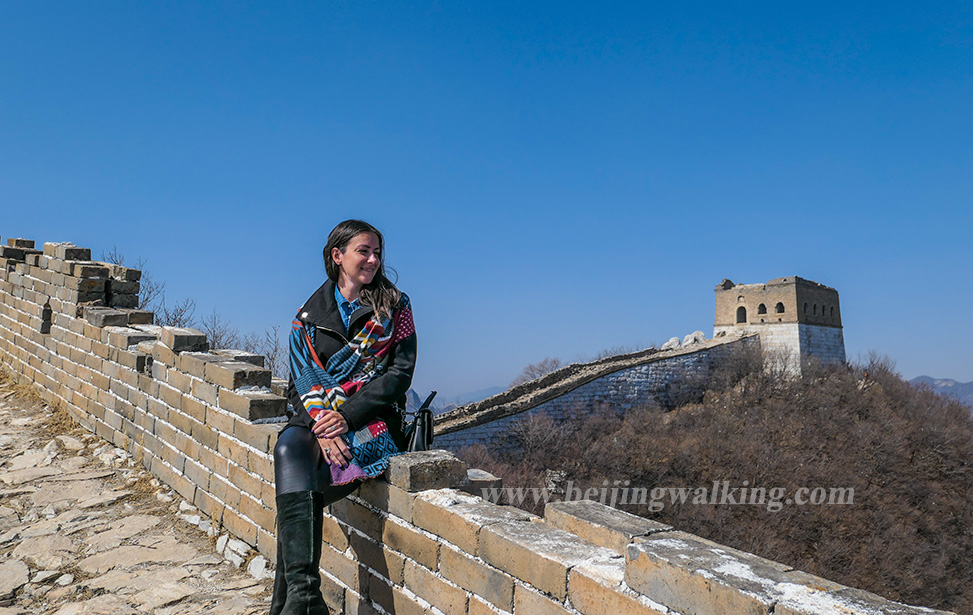Top 10 collection highlights in National Museum of China
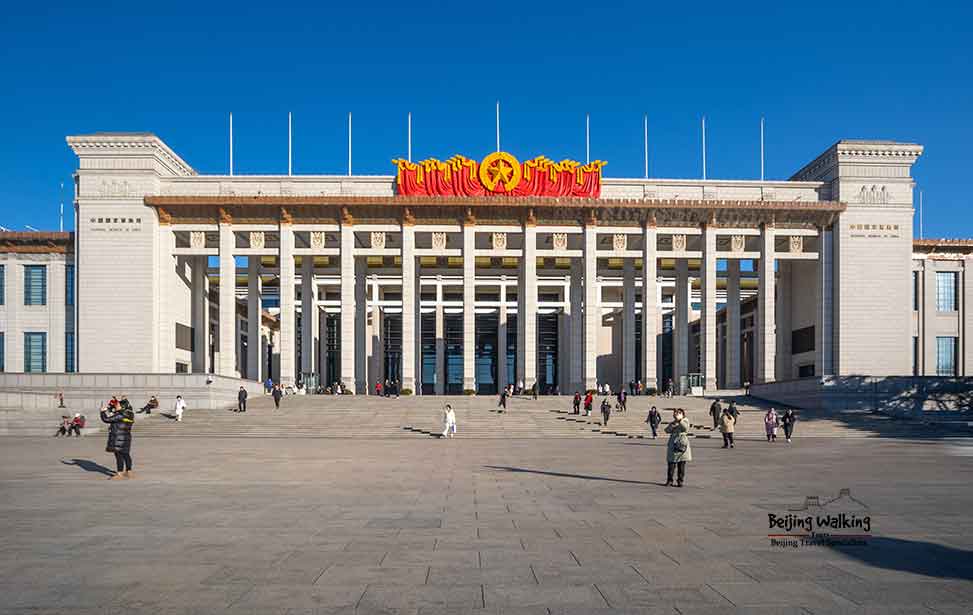
The National Museum of China (NMC), or Guobo, is China’s highest historical, cultural, and artistic institution. It represents the national collection, research, exhibition, and interpretation of representative cultural artifacts of Chinese culture. It is also considered the cultural living room of the nation. With a collection of over 1.43 million artifacts, the museum vividly showcases and bears witness to the continuous and splendid history of Chinese civilization over 5,000 years. This blog introduces the top 10 most famous collections in the National Museum and travel tips.
How to get there?
Address: No. 16 East Chang’an Street, Dongcheng District, Beijing 100006 (East side of Tian’anmen Square)
Bus Route:
You can take the No.1, No.2, No. 52, No. 82, and No.120 buses, or Sightseeing Line 2, Tourist Bus Line 1 and Line 2 and get off at Tian’anmen East Station.
Subway: You can take Metro Line 1, get off at Tian’anmen East Station, and exit through Exit C or D.
How to book the tickets?
Ticket price: FREE
Audience members can make reservations 7 days in advance through the WeChat official mini-program. “国家博物馆”
Each day is divided into three reservation time slots: 9:00-11:00, 11:00-13:30, and 13:30-16:00 (ticket reservation starts at 17:00 daily, and the deadline for ticket cancellation is 15:00 on the day of the visit).
After a successful reservation, the system will automatically send a notification of the reservation; please keep it safe.
Open time: 9:00 AM to 5:00 PM, with the last admission at 4:00 PM (Close on Monday)
Map of the Nationa Museum of China
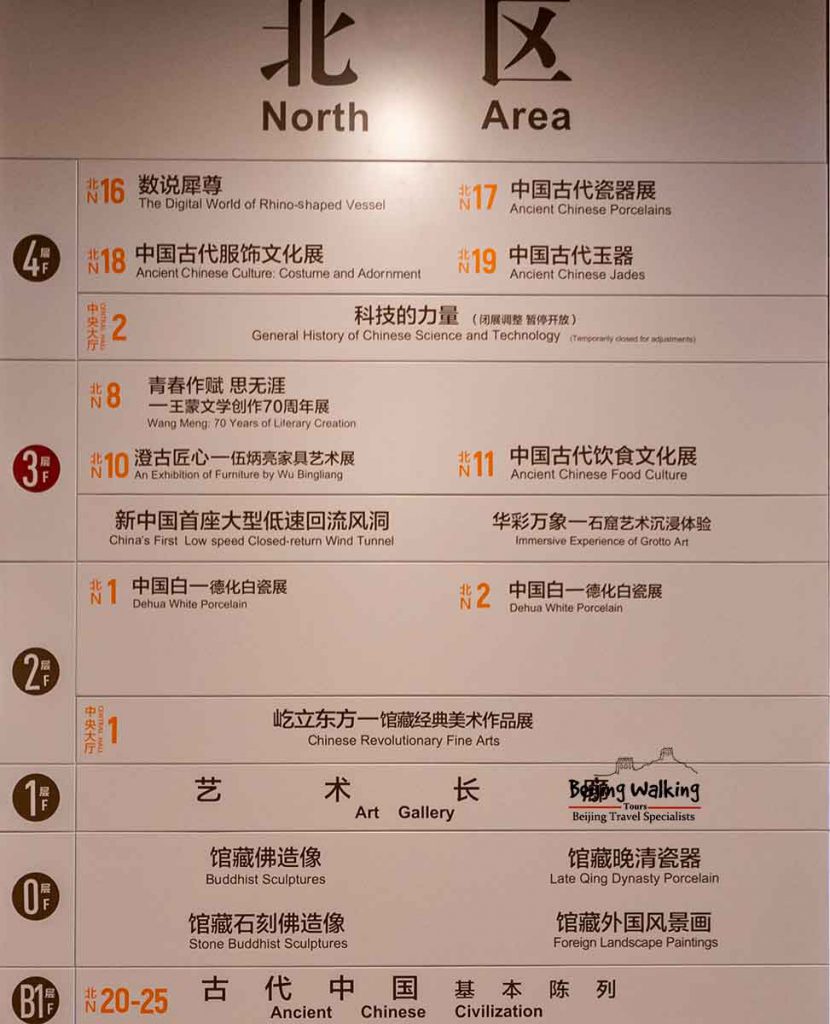
Top 10 collection highlights
1. Gold Thread and Jade Garment 金缕玉衣
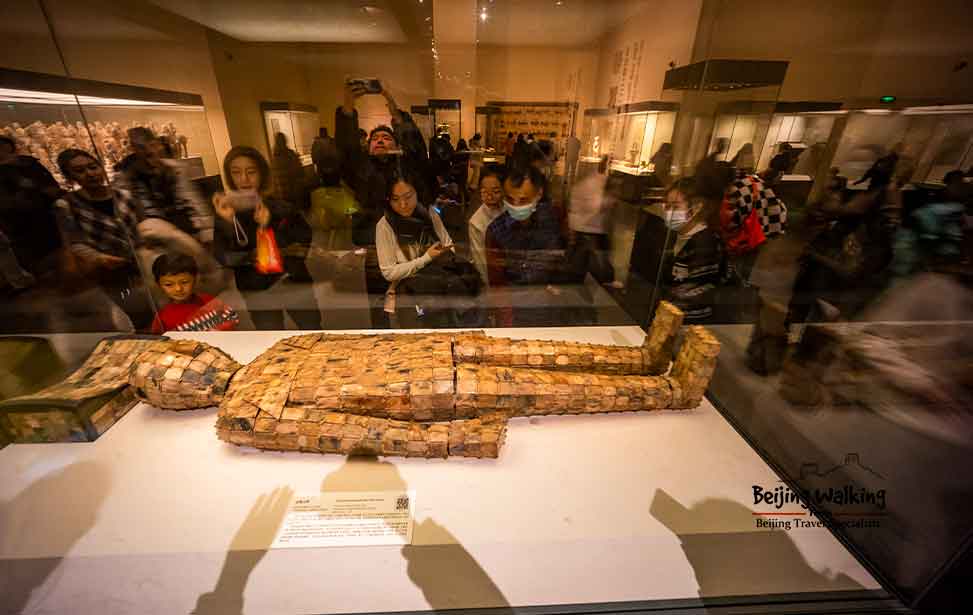
The “Gold Thread and Jade Garment “ is a funerary attire worn by emperors and nobles in the Han Dynasty. It is made by interweaving various shaped jade pieces and metallic threads. It was believed that jade could preserve the body from decay.
This “Gold Thread and Jade Garment” belongs to Price Liu Xiu, who died in 55 BC. It comprises 2,567 grams of gold thread and 1,203 pieces of jade. Although the garment was previously damaged by fire during looting, its colors have become even more vibrant.
2. Four Goat Square Zun四羊方尊
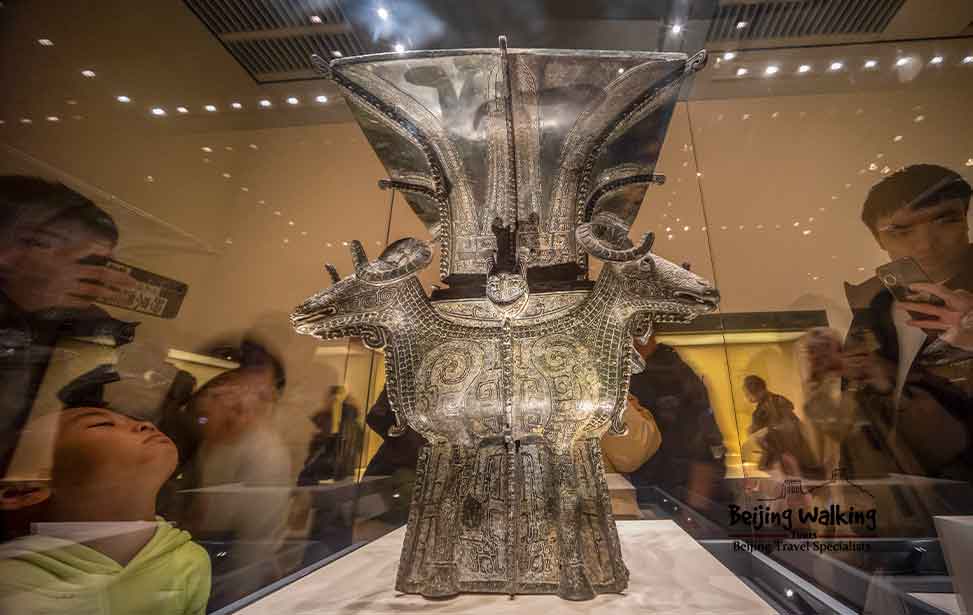
The Four-Goat Square Zun, also known as the Four-Ram Bronze Square Zun, is the largest surviving bronze ritual vessel from the Shang dynasty in China. It was used for wine and sacrificial ceremonies. This masterpiece of Chinese bronze art showcases the advanced casting techniques and rich cultural heritage of the late Shang dynasty.
The vessel is adorned with exquisite phoenix, dragon, taotie, banana leaf, and thunder patterns, displaying high craftsmanship. Regarded as the epitome of bronze artistry, it has earned a place among China’s top ten national treasures.
3. Human-Faced Fish Motifs 人面鱼纹彩陶盆
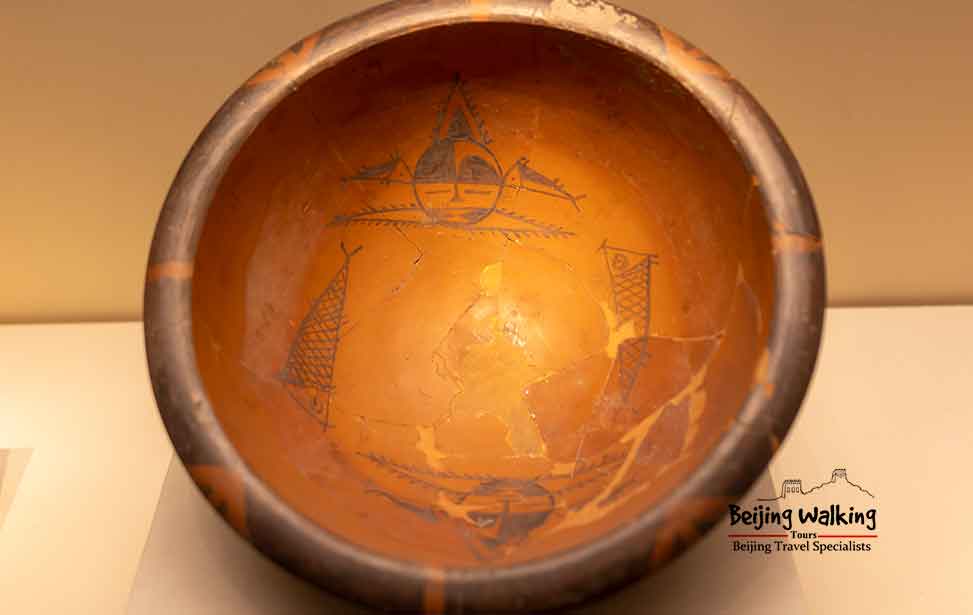
The Human-Faced Fish Pot is a painted pottery vessel from the Yangshao culture of the Neolithic period. It was unearthed in 1955 at the Banpo Site in Xi’an, Shaanxi Province. This piece is considered the most exquisite among the ten human-faced artifacts. The emergence of colored pottery in the late Neolithic period demonstrated the advanced level of ceramic technology among primitive people.
In terms of functionality, the human-faced fish patterned colored pottery basin holds the special significance of “uniting humans and fish.” The human-faced fish-patterned basin is a “funerary object” specially made for deceased children. It is used as a lid with a pot as a coffin. The human-faced fish-patterned basin’s round belly and flat mouth serve as the top cover of the funerary object, forming an interactive opening with the pot, providing a strong seal and protecting the deceased child’s remains.
In terms of decoration, the human-faced fish-patterned basin draws inspiration from the daily lives of primitive people, depicting their fishing and hunting activities. The simplified fish patterns reveal how primitive people started using simple and abstract lines to depict the dynamic beauty of fish swimming in water. The mysterious human-faced fish patterns express the wish for an abundant afterlife for the deceased child.
4. Hongshan Jade Dragon 红山玉龙
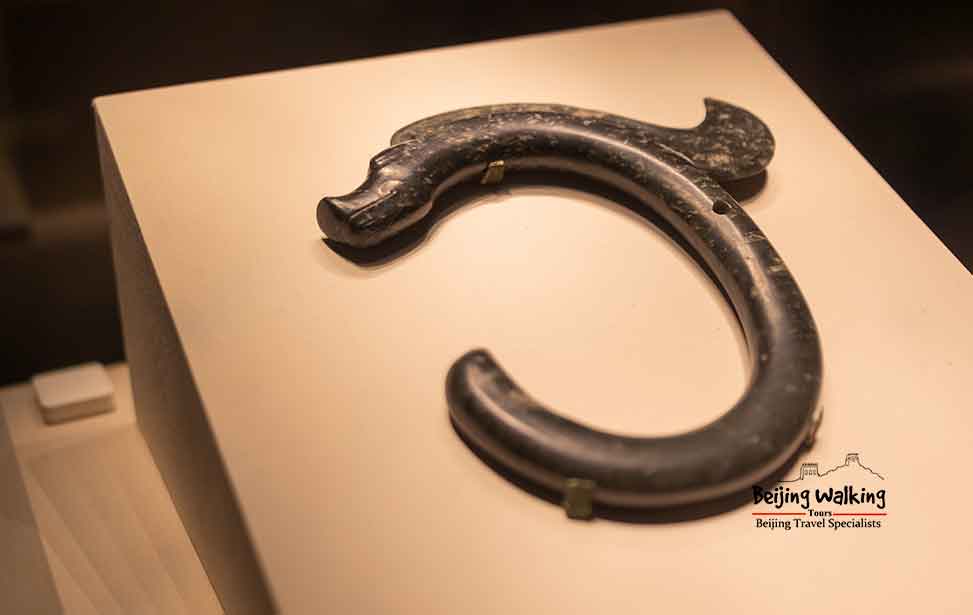
The Hongshan Jade Dragon was unearthed in 1971 at the Hongshan Site in Sain Qintara, Chifeng City, Inner Mongolia Autonomous Region. It is an artifact from the late Neolithic period of the Hongshan culture. The Hongshan Jade Dragon is a first-grade national treasure considered the “First Dragon of China.” It is believed to be the earliest representation of a dragon in Chinese culture.
5. Houmuwu Ding 后母戊鼎
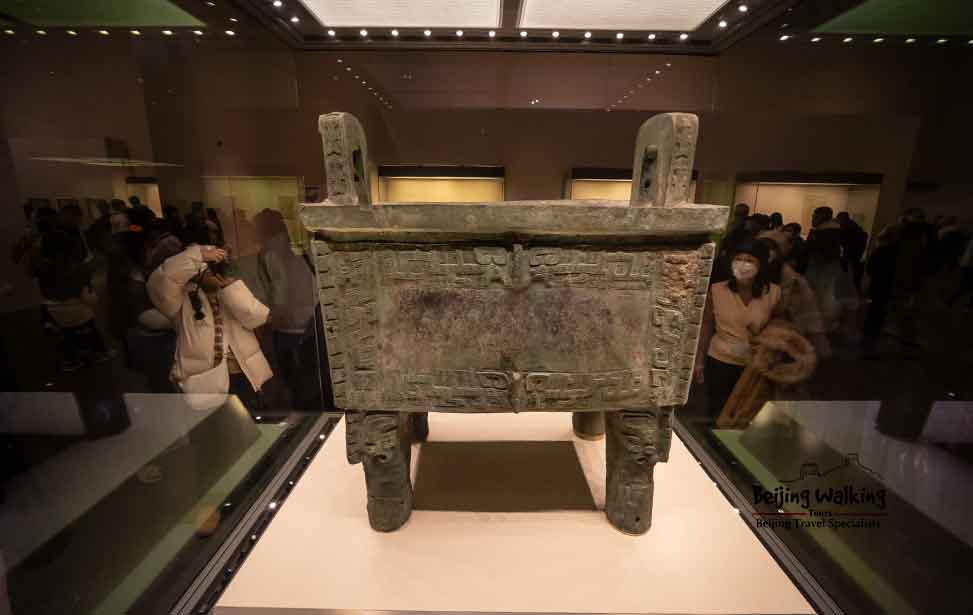
The Houmuwu Ding, a bronze square cauldron from the late Shang dynasty (approximately 14th to 11th century BCE), is the heaviest known ancient bronze artifact in China and is hailed as the “King of Bronze.” Weighing 832.84 kilograms, it stands 133 centimeters tall, with a mouth length of 112 centimeters and a mouth width of 79.2 centimeters. It was unearthed in 1939 at the Wuguan Village in Anyang City, Henan Province.
The cauldron was cast by either King Zu Geng or King Zu Jia of the Shang dynasty as a sacrificial offering to their mother, Queen Wu. The inner wall of the belly of the cauldron bears an inscription of the three characters “Hou Mu Wu,” which is the temple name of the Shang queen. The meticulous craftsmanship and intricate organization involved in its production demonstrate the highly developed bronze culture of the late Shang dynasty.
6. Sanxingdui bronze masks 三星堆铜面
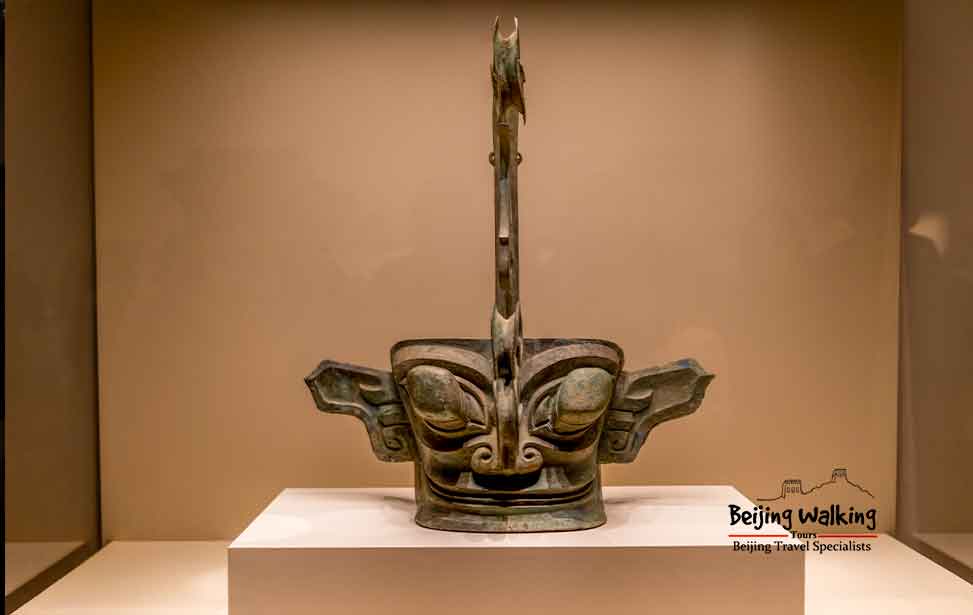
The Sanxingdui bronze masks are ancient artifacts discovered at the Sanxingdui archaeological site in China. These masks, created by the Shu civilization over 4,000 years ago, feature intricate designs, animal imagery, and mythical motifs. They offer valuable insights into the region’s ancient civilization and religious beliefs. The masks are considered both artistic treasures and important historical and cultural relics.
It is different from any human culture discovered today, and there are still a lot of secrets. For example, what does the face look like? The archeologists didn’t find any signal words from the wild sites of Sanxigndui today.
7. Eagle-shaped Pottery Ding 陶鹰鼎
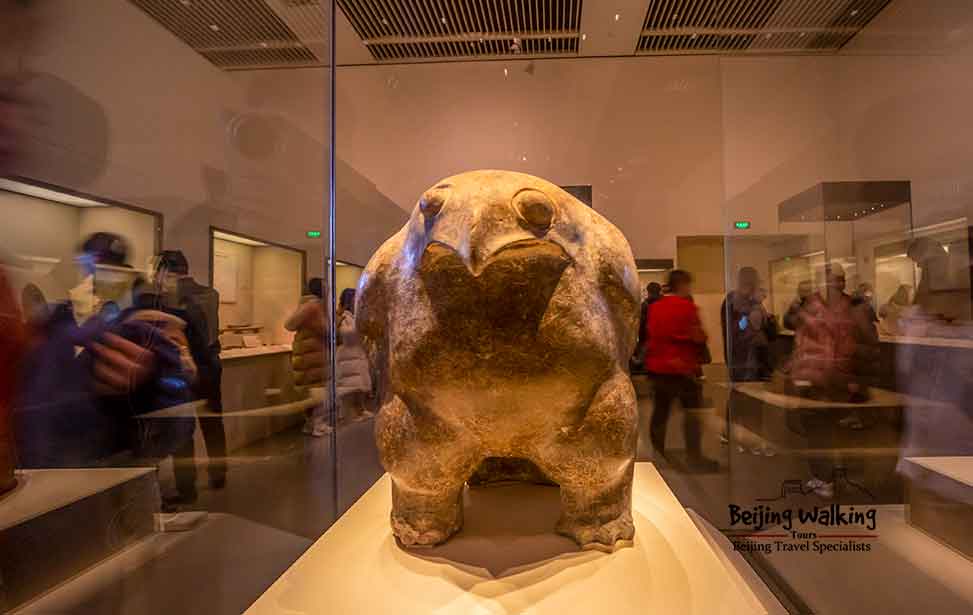
The Tao Yingding, an eagle-shaped pottery tripod, is a remarkable sculpture from the late Neolithic Yangshao culture. Unearthed in 1958 in Shaanxi Province, it combines a tripod vessel’s features with an eagle’s beauty. Standing at 35.8 cm tall, with a mouth diameter of 23.3 cm and a maximum belly diameter of 32 cm, the Tao Yingding exemplifies the perfect blend of art and functionality.
8. Guo Jizi Bai Pan 虢季子白盘
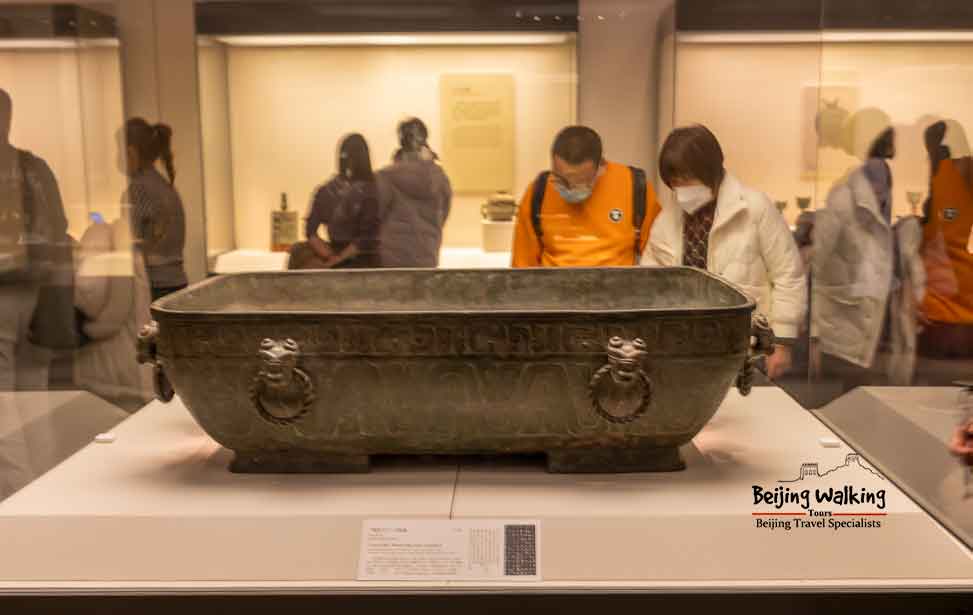
The Guoji Zi Bai Pan is a unique artifact from the Zhou period, discovered in Baoji, Shaanxi Province. It resembles a large bathtub and weighs 215.3 kg. The bottom of the pan features an inscription of 111 characters, recounting Guoji Zi Bai’s victory over the Xianyun tribe in 816 BC. This artifact offers insights into the origins of the later Qin Stone Drum Script and Qin Small Seal Script. It is a significant cultural relic in China.
9. The Drummer and Chanting Performer Figurine 击鼓说唱俑
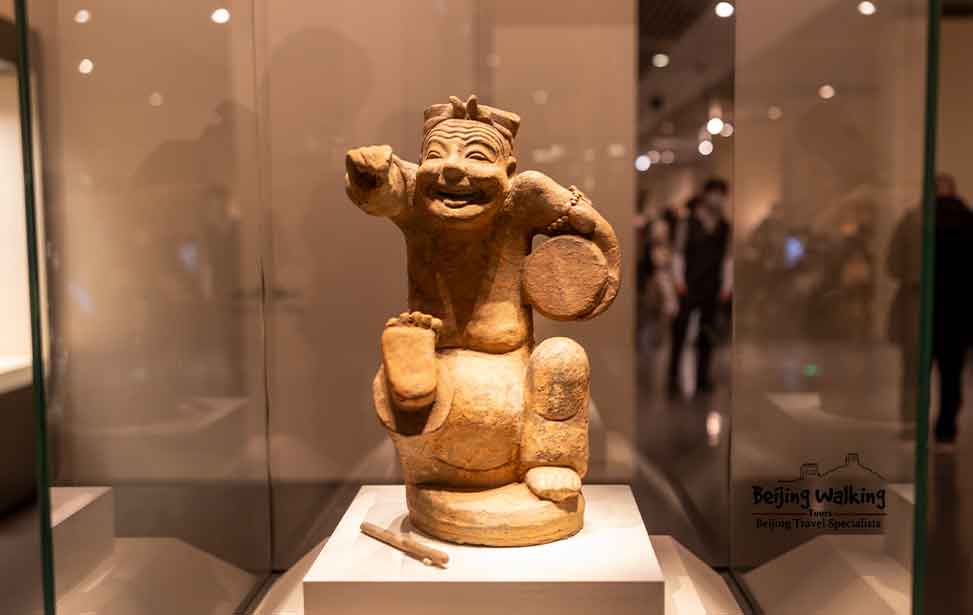
The Drummer Chanting Figurine is a painted pottery figurine from the Eastern Han Dynasty. It was unearthed in 1957 in the Eastern Han tomb on Tianhui Mountain, Chengdu, Sichuan Province. It is known as the “first figurine of the Han Dynasty.” Its discovery also proves that as early as the Eastern Han Dynasty, the art of chanting had become mature and widely spread among the people.
10. The Tri-color Glazed Pottery Camel Carrying Musicians 三彩釉陶载乐骆驼
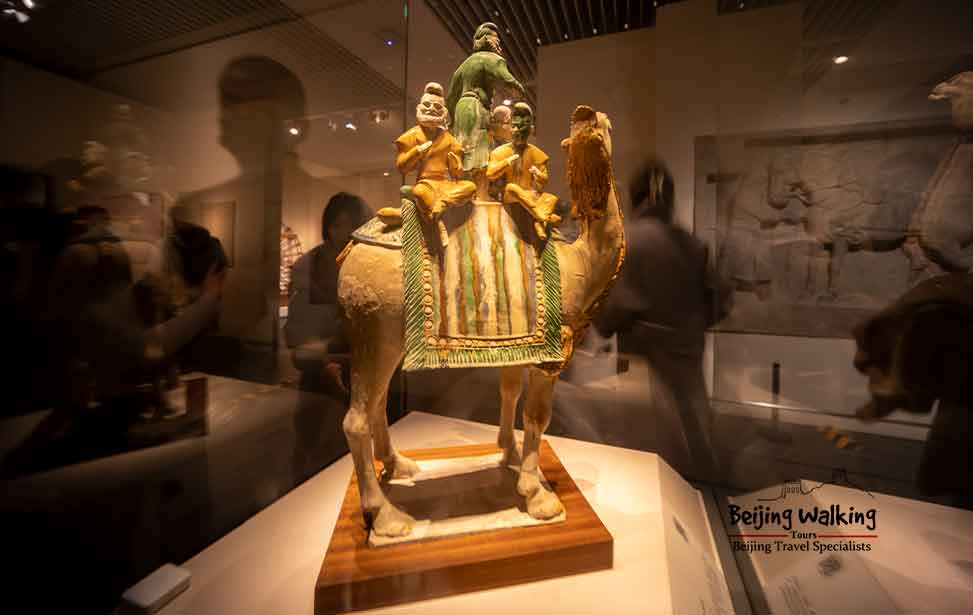
The Tricolored Glazed Pottery Camel with Musicians is a colorful glazed artifact from the Tang Dynasty. It was unearthed in 1957 from the tomb of Xian Yu Ting Hui in Xi’an, Shaanxi Province. The camel’s head stands at a height of 58.4 cm, with a length of 43.4 cm from head to tail—the dancing figurine on top measures 25.1 cm in height. The camel carries five adult male figures representing the Han and Hu ethnic groups. Four are seated and playing musical instruments while the central figure, Hu, is dancing. This pottery figurine also reflects the economic and cultural exchanges between the Tang Dynasty and the Western Regions, as well as the folk customs of the time.
The National Museum of China has a vast collection of treasures. Due to limitations in length, other famous artifacts such as the Painted Stork and Fish Stone Axe Pot, the Da Yu Ding, the Empress Dowager Xiao Duo’s Phoenix Crown, the Sanxingdui Bronze Mask, and the Gold and Silver Inlaid Cloud and Wave Bronze Rhinoceros Vessel are not covered here. We encourage readers to discover these remarkable pieces personally.






